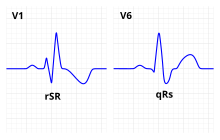User:Mr. Ibrahem/Right bundle branch block
| Right bundle branch block | |
|---|---|
 | |
| ECG characteristics of a typical RBBB showing wide QRS complexes with a terminal R wave in lead V1 and a prolonged S wave in lead V6. | |
| Specialty | Cardiology |
| Symptoms | None[1] |
| Complications | None[1] |
| Causes | Unknown, heart damage, increased right ventricular pressure, high blood potassium[1] |
| Diagnostic method | Electrocardiogram (ECG)[1] |
| Differential diagnosis | Left bundle branch block, ventricular tachycardia, Brugada syndrome[1] |
| Treatment | Based on underlying disorder[1] |
| Frequency | Fairly common[2] |
Right bundle branch block (RBBB) is a type of electrical conduction abnormality of the heart seen on the electrocardiogram (ECG).[1] In and of itself, it results in no symptoms and generally results in no complications.[1] It may be temporary or permanently present.[2]
Causes include heart damage, such as a heart attack or myocarditis, increased right ventricular pressure, such as with pulmonary embolism or cor pulmonale, and rarely high blood potassium.[1] Though some cases occurs without any specific cause.[2] The underlying mechanism involves damage to the right bundle branch.[1]
Diagnosis requires that the QRS complex is greater than 120 ms and an rsR' wave is present in lead V1 or V2.[2] The T waves are generally flipped in V1 and V2.[2] When the QRS duration is less than 120 ms, but the other criteria are present, it is called an incomplete RBBB.[1] Its presence does not interfere with the diagnosis of a heart attack.[1]
No specific treatment is generally required.[1] In the setting of heart failure, cardiac resynchronization therapy may be indicated.[1] RBBB is present in about 0.2% to 0.8% of ECGs.[2] Up to 11% of people are affected by the age of 80.[1]
References[edit]
- ^ a b c d e f g h i j k l m n o Harkness, WT; Hicks, M (January 2020). "Right Bundle Branch Block". PMID 29939649.
{{cite journal}}: Cite journal requires|journal=(help) - ^ a b c d e f Roberts, David (2019). Mastering the 12-Lead EKG. Springer Publishing Company. p. 316. ISBN 978-0-8261-8194-7. Archived from the original on 2021-08-29. Retrieved 2020-12-30.
